Finance Report: Property Economics and Investment Analysis
VerifiedAdded on 2021/04/21
|12
|2537
|24
Report
AI Summary
This report delves into the core aspects of property economics and finance, commencing with an exploration of various funding sources available to developers, including personal savings, bank loans, and emerging alternatives like private funders and joint ventures. It then examines financing techniques, highlighting the significance of capital structure and its impact on firm leverage, investor returns, and cost of capital. Evaluation techniques, particularly Net Present Value (NPV) and capitalization rates, are analyzed to assess property value and profitability. The report also addresses critical risk management strategies, focusing on market risks, liquidity risks, and correlation analysis, providing insights into mitigating investment risks. Finally, the report considers the overall property economics, evaluating the impact of interest rate changes, government policies, unemployment, and supply dynamics on mixed-use development proposals and investment decisions within the real estate sector. The report provides a comprehensive overview of property finance and investment.

qwertyuiopasdfghjklzxcvbnmqw
ertyuiopasdfghjklzxcvbnmqwert
yuiopasdfghjklzxcvbnmqwertyui
opasdfghjklzxcvbnmqwertyuiop
asdfghjklzxcvbnmqwertyuiopasd
fghjklzxcvbnmqwertyuiopasdfgh
jklzxcvbnmqwertyuiopasdfghjkl
zxcvbnmqwertyuiopasdfghjklzxc
vbnmqwertyuiopasdfghjklzxcvb
nmqwertyuiopasdfghjklzxcvbnm
PROPERTY ECONOMICS AND FINANCE
[Type the document subtitle]
[Pick the date]
#04074
ertyuiopasdfghjklzxcvbnmqwert
yuiopasdfghjklzxcvbnmqwertyui
opasdfghjklzxcvbnmqwertyuiop
asdfghjklzxcvbnmqwertyuiopasd
fghjklzxcvbnmqwertyuiopasdfgh
jklzxcvbnmqwertyuiopasdfghjkl
zxcvbnmqwertyuiopasdfghjklzxc
vbnmqwertyuiopasdfghjklzxcvb
nmqwertyuiopasdfghjklzxcvbnm
PROPERTY ECONOMICS AND FINANCE
[Type the document subtitle]
[Pick the date]
#04074
Paraphrase This Document
Need a fresh take? Get an instant paraphrase of this document with our AI Paraphraser
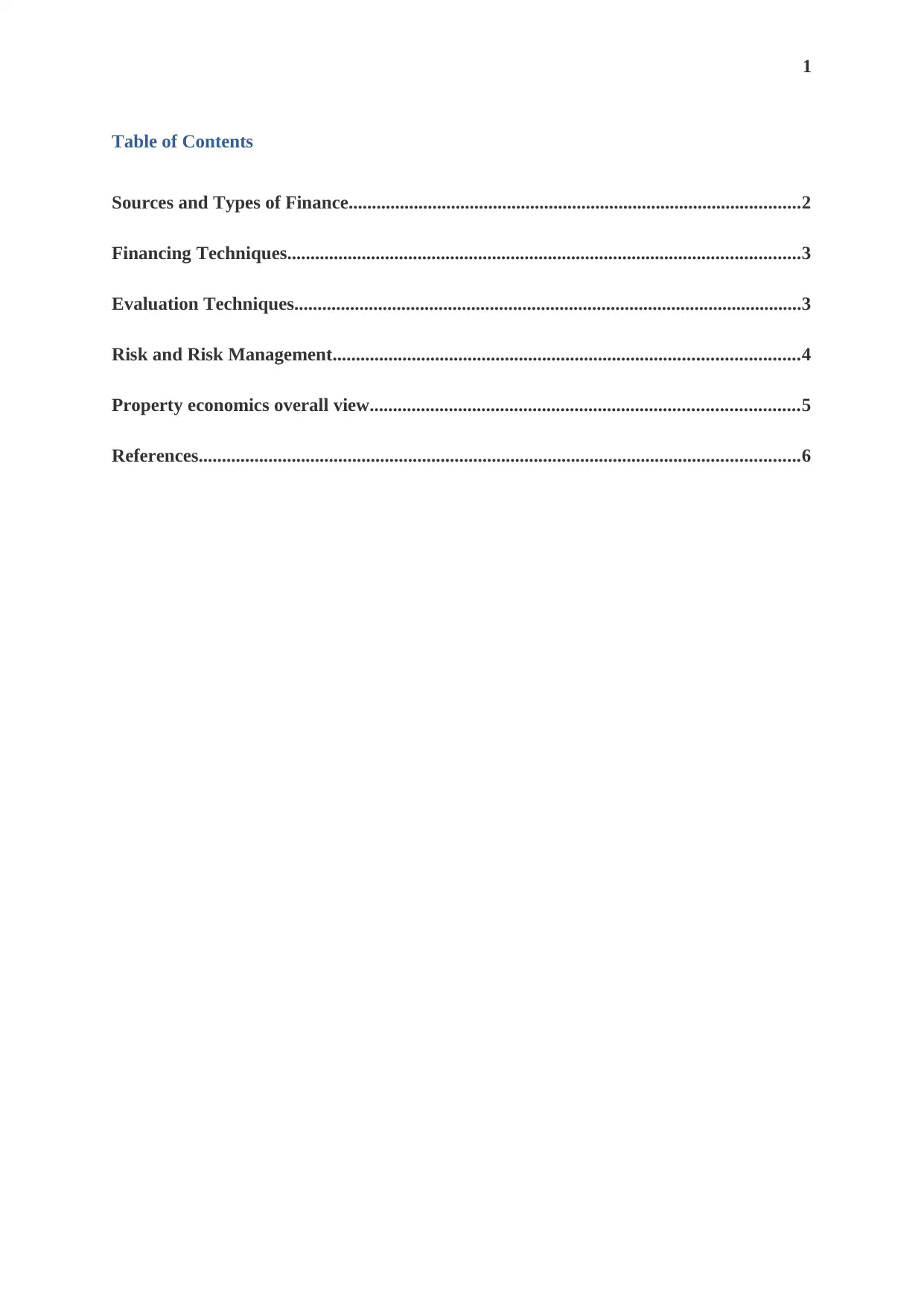
1
Table of Contents
Sources and Types of Finance.................................................................................................2
Financing Techniques..............................................................................................................3
Evaluation Techniques.............................................................................................................3
Risk and Risk Management....................................................................................................4
Property economics overall view............................................................................................5
References.................................................................................................................................6
Table of Contents
Sources and Types of Finance.................................................................................................2
Financing Techniques..............................................................................................................3
Evaluation Techniques.............................................................................................................3
Risk and Risk Management....................................................................................................4
Property economics overall view............................................................................................5
References.................................................................................................................................6
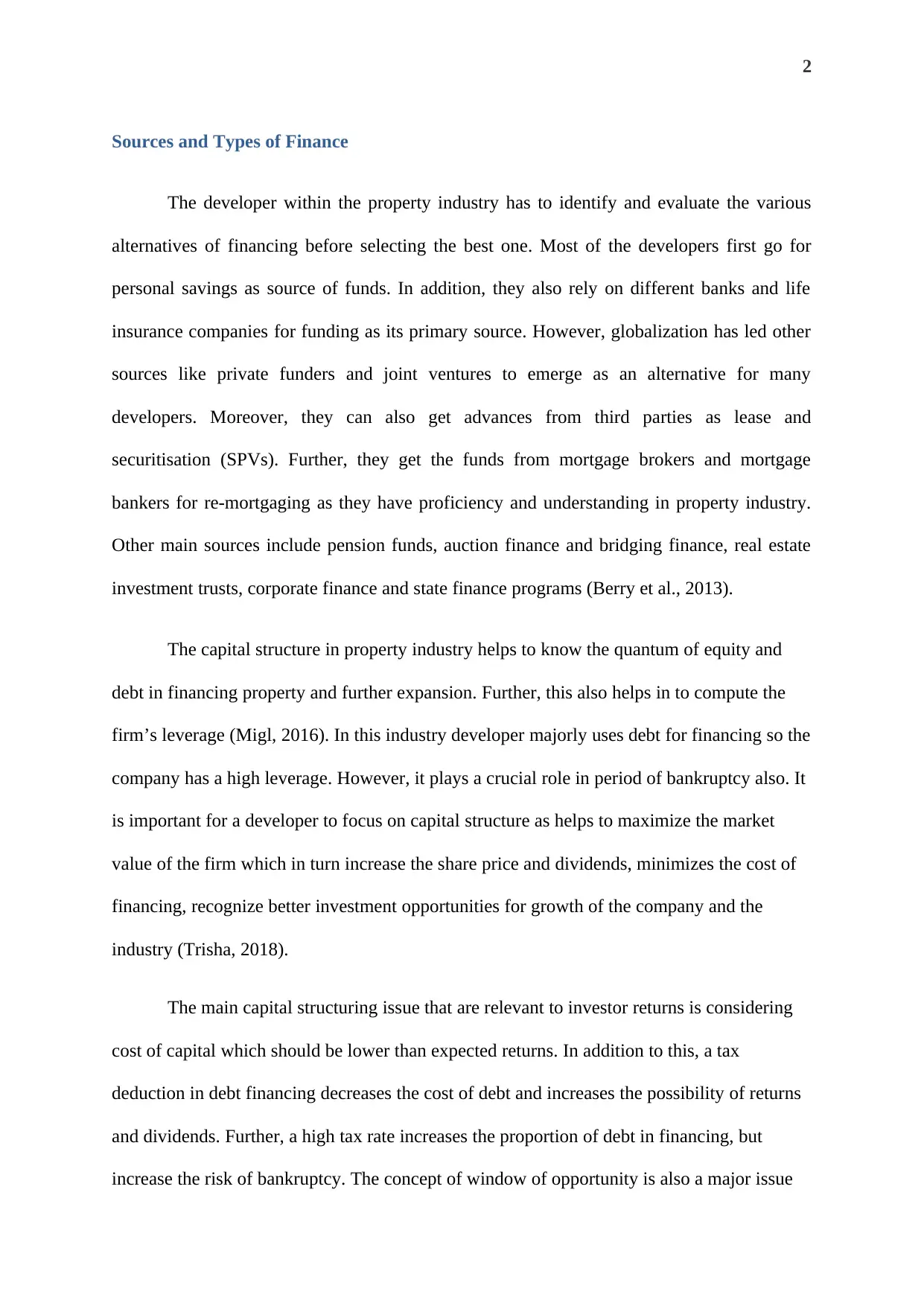
2
Sources and Types of Finance
The developer within the property industry has to identify and evaluate the various
alternatives of financing before selecting the best one. Most of the developers first go for
personal savings as source of funds. In addition, they also rely on different banks and life
insurance companies for funding as its primary source. However, globalization has led other
sources like private funders and joint ventures to emerge as an alternative for many
developers. Moreover, they can also get advances from third parties as lease and
securitisation (SPVs). Further, they get the funds from mortgage brokers and mortgage
bankers for re-mortgaging as they have proficiency and understanding in property industry.
Other main sources include pension funds, auction finance and bridging finance, real estate
investment trusts, corporate finance and state finance programs (Berry et al., 2013).
The capital structure in property industry helps to know the quantum of equity and
debt in financing property and further expansion. Further, this also helps in to compute the
firm’s leverage (Migl, 2016). In this industry developer majorly uses debt for financing so the
company has a high leverage. However, it plays a crucial role in period of bankruptcy also. It
is important for a developer to focus on capital structure as helps to maximize the market
value of the firm which in turn increase the share price and dividends, minimizes the cost of
financing, recognize better investment opportunities for growth of the company and the
industry (Trisha, 2018).
The main capital structuring issue that are relevant to investor returns is considering
cost of capital which should be lower than expected returns. In addition to this, a tax
deduction in debt financing decreases the cost of debt and increases the possibility of returns
and dividends. Further, a high tax rate increases the proportion of debt in financing, but
increase the risk of bankruptcy. The concept of window of opportunity is also a major issue
Sources and Types of Finance
The developer within the property industry has to identify and evaluate the various
alternatives of financing before selecting the best one. Most of the developers first go for
personal savings as source of funds. In addition, they also rely on different banks and life
insurance companies for funding as its primary source. However, globalization has led other
sources like private funders and joint ventures to emerge as an alternative for many
developers. Moreover, they can also get advances from third parties as lease and
securitisation (SPVs). Further, they get the funds from mortgage brokers and mortgage
bankers for re-mortgaging as they have proficiency and understanding in property industry.
Other main sources include pension funds, auction finance and bridging finance, real estate
investment trusts, corporate finance and state finance programs (Berry et al., 2013).
The capital structure in property industry helps to know the quantum of equity and
debt in financing property and further expansion. Further, this also helps in to compute the
firm’s leverage (Migl, 2016). In this industry developer majorly uses debt for financing so the
company has a high leverage. However, it plays a crucial role in period of bankruptcy also. It
is important for a developer to focus on capital structure as helps to maximize the market
value of the firm which in turn increase the share price and dividends, minimizes the cost of
financing, recognize better investment opportunities for growth of the company and the
industry (Trisha, 2018).
The main capital structuring issue that are relevant to investor returns is considering
cost of capital which should be lower than expected returns. In addition to this, a tax
deduction in debt financing decreases the cost of debt and increases the possibility of returns
and dividends. Further, a high tax rate increases the proportion of debt in financing, but
increase the risk of bankruptcy. The concept of window of opportunity is also a major issue
⊘ This is a preview!⊘
Do you want full access?
Subscribe today to unlock all pages.

Trusted by 1+ million students worldwide
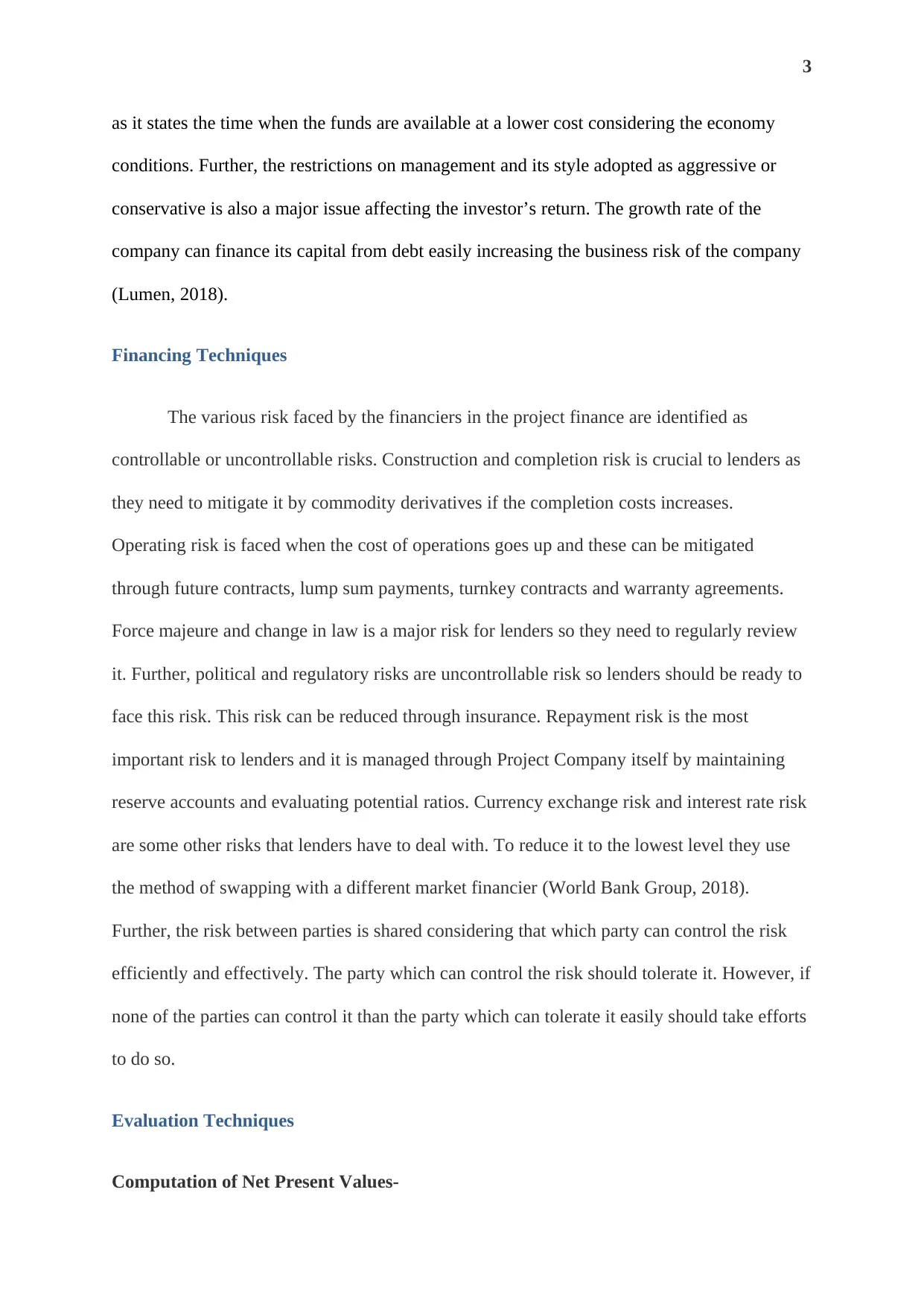
3
as it states the time when the funds are available at a lower cost considering the economy
conditions. Further, the restrictions on management and its style adopted as aggressive or
conservative is also a major issue affecting the investor’s return. The growth rate of the
company can finance its capital from debt easily increasing the business risk of the company
(Lumen, 2018).
Financing Techniques
The various risk faced by the financiers in the project finance are identified as
controllable or uncontrollable risks. Construction and completion risk is crucial to lenders as
they need to mitigate it by commodity derivatives if the completion costs increases.
Operating risk is faced when the cost of operations goes up and these can be mitigated
through future contracts, lump sum payments, turnkey contracts and warranty agreements.
Force majeure and change in law is a major risk for lenders so they need to regularly review
it. Further, political and regulatory risks are uncontrollable risk so lenders should be ready to
face this risk. This risk can be reduced through insurance. Repayment risk is the most
important risk to lenders and it is managed through Project Company itself by maintaining
reserve accounts and evaluating potential ratios. Currency exchange risk and interest rate risk
are some other risks that lenders have to deal with. To reduce it to the lowest level they use
the method of swapping with a different market financier (World Bank Group, 2018).
Further, the risk between parties is shared considering that which party can control the risk
efficiently and effectively. The party which can control the risk should tolerate it. However, if
none of the parties can control it than the party which can tolerate it easily should take efforts
to do so.
Evaluation Techniques
Computation of Net Present Values-
as it states the time when the funds are available at a lower cost considering the economy
conditions. Further, the restrictions on management and its style adopted as aggressive or
conservative is also a major issue affecting the investor’s return. The growth rate of the
company can finance its capital from debt easily increasing the business risk of the company
(Lumen, 2018).
Financing Techniques
The various risk faced by the financiers in the project finance are identified as
controllable or uncontrollable risks. Construction and completion risk is crucial to lenders as
they need to mitigate it by commodity derivatives if the completion costs increases.
Operating risk is faced when the cost of operations goes up and these can be mitigated
through future contracts, lump sum payments, turnkey contracts and warranty agreements.
Force majeure and change in law is a major risk for lenders so they need to regularly review
it. Further, political and regulatory risks are uncontrollable risk so lenders should be ready to
face this risk. This risk can be reduced through insurance. Repayment risk is the most
important risk to lenders and it is managed through Project Company itself by maintaining
reserve accounts and evaluating potential ratios. Currency exchange risk and interest rate risk
are some other risks that lenders have to deal with. To reduce it to the lowest level they use
the method of swapping with a different market financier (World Bank Group, 2018).
Further, the risk between parties is shared considering that which party can control the risk
efficiently and effectively. The party which can control the risk should tolerate it. However, if
none of the parties can control it than the party which can tolerate it easily should take efforts
to do so.
Evaluation Techniques
Computation of Net Present Values-
Paraphrase This Document
Need a fresh take? Get an instant paraphrase of this document with our AI Paraphraser
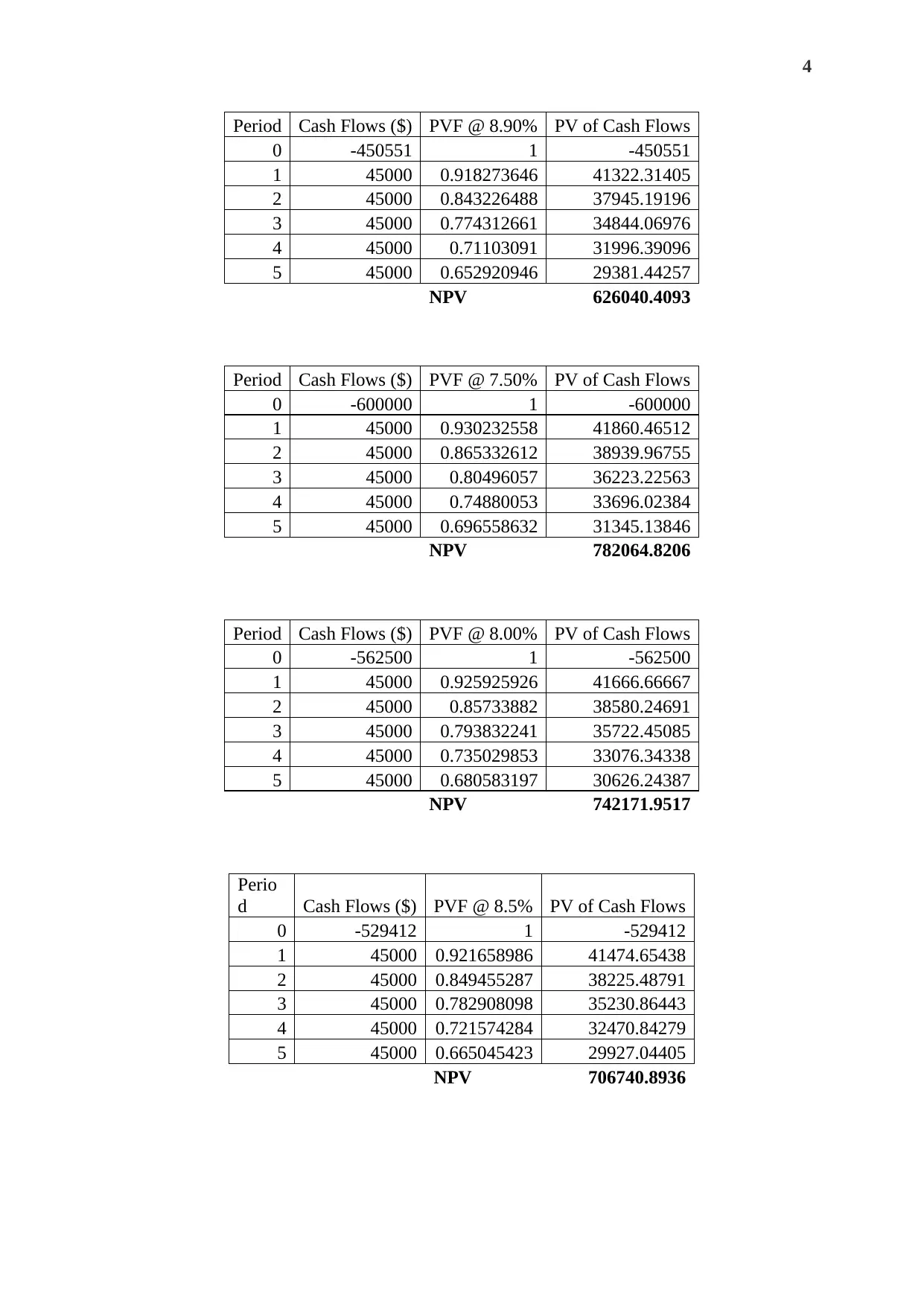
4
Period Cash Flows ($) PVF @ 8.90% PV of Cash Flows
0 -450551 1 -450551
1 45000 0.918273646 41322.31405
2 45000 0.843226488 37945.19196
3 45000 0.774312661 34844.06976
4 45000 0.71103091 31996.39096
5 45000 0.652920946 29381.44257
NPV 626040.4093
Period Cash Flows ($) PVF @ 7.50% PV of Cash Flows
0 -600000 1 -600000
1 45000 0.930232558 41860.46512
2 45000 0.865332612 38939.96755
3 45000 0.80496057 36223.22563
4 45000 0.74880053 33696.02384
5 45000 0.696558632 31345.13846
NPV 782064.8206
Period Cash Flows ($) PVF @ 8.00% PV of Cash Flows
0 -562500 1 -562500
1 45000 0.925925926 41666.66667
2 45000 0.85733882 38580.24691
3 45000 0.793832241 35722.45085
4 45000 0.735029853 33076.34338
5 45000 0.680583197 30626.24387
NPV 742171.9517
Perio
d Cash Flows ($) PVF @ 8.5% PV of Cash Flows
0 -529412 1 -529412
1 45000 0.921658986 41474.65438
2 45000 0.849455287 38225.48791
3 45000 0.782908098 35230.86443
4 45000 0.721574284 32470.84279
5 45000 0.665045423 29927.04405
NPV 706740.8936
Period Cash Flows ($) PVF @ 8.90% PV of Cash Flows
0 -450551 1 -450551
1 45000 0.918273646 41322.31405
2 45000 0.843226488 37945.19196
3 45000 0.774312661 34844.06976
4 45000 0.71103091 31996.39096
5 45000 0.652920946 29381.44257
NPV 626040.4093
Period Cash Flows ($) PVF @ 7.50% PV of Cash Flows
0 -600000 1 -600000
1 45000 0.930232558 41860.46512
2 45000 0.865332612 38939.96755
3 45000 0.80496057 36223.22563
4 45000 0.74880053 33696.02384
5 45000 0.696558632 31345.13846
NPV 782064.8206
Period Cash Flows ($) PVF @ 8.00% PV of Cash Flows
0 -562500 1 -562500
1 45000 0.925925926 41666.66667
2 45000 0.85733882 38580.24691
3 45000 0.793832241 35722.45085
4 45000 0.735029853 33076.34338
5 45000 0.680583197 30626.24387
NPV 742171.9517
Perio
d Cash Flows ($) PVF @ 8.5% PV of Cash Flows
0 -529412 1 -529412
1 45000 0.921658986 41474.65438
2 45000 0.849455287 38225.48791
3 45000 0.782908098 35230.86443
4 45000 0.721574284 32470.84279
5 45000 0.665045423 29927.04405
NPV 706740.8936

5
Period Cash Flows ($) PVF @ 9% PV of Cash Flows
0 -500000 1 -500000
1 45000
0.91743119
3 41284.40367
2 45000
0.84167999
3 37875.5997
3 45000 0.77218348 34748.2566
4 45000
0.70842521
1 31879.1345
5 45000
0.64993138
6 29246.91238
NPV 675034.3069
Perio
d Cash Flows ($) PVF @ 9.5% PV of Cash Flows
0 -473684 1 -473684
1 45000 0.913242009 41095.89041
2 45000 0.834010967 37530.49353
3 45000 0.761653851 34274.42331
4 45000 0.695574293 31300.84321
5 45000 0.635227665 28585.24494
NPV 646470.8954
Perio
d Cash Flows ($) PVF @ 10.00% PV of Cash Flows
0 -450000 1 -450000
1 45000 0.909090909 40909.09091
2 45000 0.826446281 37190.08264
3 45000 0.751314801 33809.16604
4 45000 0.683013455 30735.60549
5 45000 0.620921323 27941.45954
NPV 620585.4046
Perio
d Cash Flows ($) PVF @ 10.50% PV of Cash Flows
0 -428571 1 -428571
1 45000 0.904977376 40723.9819
2 45000 0.81898405 36854.28226
3 45000 0.741162036 33352.29164
4 45000 0.670734875 30183.06936
5 45000 0.606999887 27314.99489
Period Cash Flows ($) PVF @ 9% PV of Cash Flows
0 -500000 1 -500000
1 45000
0.91743119
3 41284.40367
2 45000
0.84167999
3 37875.5997
3 45000 0.77218348 34748.2566
4 45000
0.70842521
1 31879.1345
5 45000
0.64993138
6 29246.91238
NPV 675034.3069
Perio
d Cash Flows ($) PVF @ 9.5% PV of Cash Flows
0 -473684 1 -473684
1 45000 0.913242009 41095.89041
2 45000 0.834010967 37530.49353
3 45000 0.761653851 34274.42331
4 45000 0.695574293 31300.84321
5 45000 0.635227665 28585.24494
NPV 646470.8954
Perio
d Cash Flows ($) PVF @ 10.00% PV of Cash Flows
0 -450000 1 -450000
1 45000 0.909090909 40909.09091
2 45000 0.826446281 37190.08264
3 45000 0.751314801 33809.16604
4 45000 0.683013455 30735.60549
5 45000 0.620921323 27941.45954
NPV 620585.4046
Perio
d Cash Flows ($) PVF @ 10.50% PV of Cash Flows
0 -428571 1 -428571
1 45000 0.904977376 40723.9819
2 45000 0.81898405 36854.28226
3 45000 0.741162036 33352.29164
4 45000 0.670734875 30183.06936
5 45000 0.606999887 27314.99489
⊘ This is a preview!⊘
Do you want full access?
Subscribe today to unlock all pages.

Trusted by 1+ million students worldwide
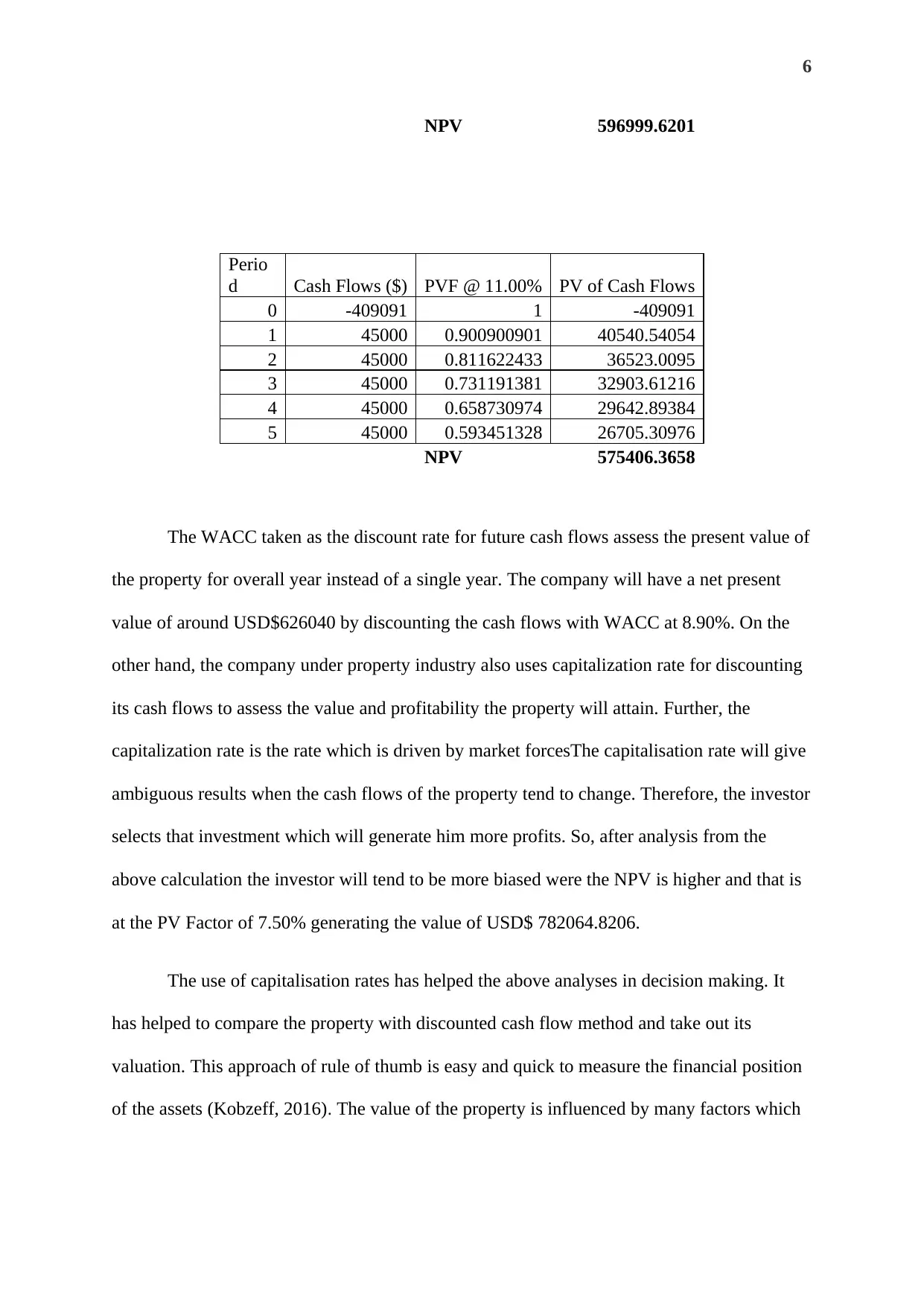
6
NPV 596999.6201
Perio
d Cash Flows ($) PVF @ 11.00% PV of Cash Flows
0 -409091 1 -409091
1 45000 0.900900901 40540.54054
2 45000 0.811622433 36523.0095
3 45000 0.731191381 32903.61216
4 45000 0.658730974 29642.89384
5 45000 0.593451328 26705.30976
NPV 575406.3658
The WACC taken as the discount rate for future cash flows assess the present value of
the property for overall year instead of a single year. The company will have a net present
value of around USD$626040 by discounting the cash flows with WACC at 8.90%. On the
other hand, the company under property industry also uses capitalization rate for discounting
its cash flows to assess the value and profitability the property will attain. Further, the
capitalization rate is the rate which is driven by market forcesThe capitalisation rate will give
ambiguous results when the cash flows of the property tend to change. Therefore, the investor
selects that investment which will generate him more profits. So, after analysis from the
above calculation the investor will tend to be more biased were the NPV is higher and that is
at the PV Factor of 7.50% generating the value of USD$ 782064.8206.
The use of capitalisation rates has helped the above analyses in decision making. It
has helped to compare the property with discounted cash flow method and take out its
valuation. This approach of rule of thumb is easy and quick to measure the financial position
of the assets (Kobzeff, 2016). The value of the property is influenced by many factors which
NPV 596999.6201
Perio
d Cash Flows ($) PVF @ 11.00% PV of Cash Flows
0 -409091 1 -409091
1 45000 0.900900901 40540.54054
2 45000 0.811622433 36523.0095
3 45000 0.731191381 32903.61216
4 45000 0.658730974 29642.89384
5 45000 0.593451328 26705.30976
NPV 575406.3658
The WACC taken as the discount rate for future cash flows assess the present value of
the property for overall year instead of a single year. The company will have a net present
value of around USD$626040 by discounting the cash flows with WACC at 8.90%. On the
other hand, the company under property industry also uses capitalization rate for discounting
its cash flows to assess the value and profitability the property will attain. Further, the
capitalization rate is the rate which is driven by market forcesThe capitalisation rate will give
ambiguous results when the cash flows of the property tend to change. Therefore, the investor
selects that investment which will generate him more profits. So, after analysis from the
above calculation the investor will tend to be more biased were the NPV is higher and that is
at the PV Factor of 7.50% generating the value of USD$ 782064.8206.
The use of capitalisation rates has helped the above analyses in decision making. It
has helped to compare the property with discounted cash flow method and take out its
valuation. This approach of rule of thumb is easy and quick to measure the financial position
of the assets (Kobzeff, 2016). The value of the property is influenced by many factors which
Paraphrase This Document
Need a fresh take? Get an instant paraphrase of this document with our AI Paraphraser
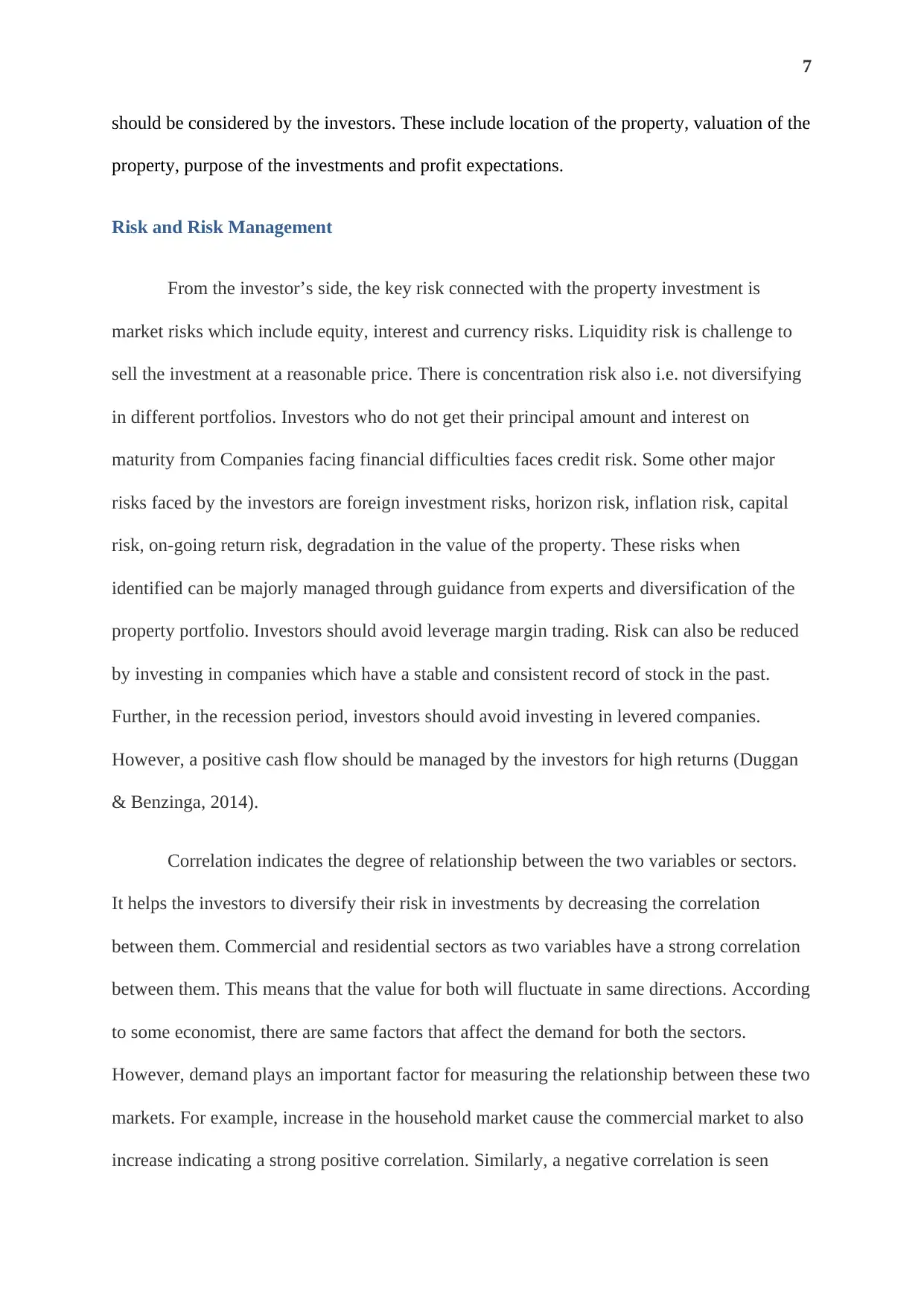
7
should be considered by the investors. These include location of the property, valuation of the
property, purpose of the investments and profit expectations.
Risk and Risk Management
From the investor’s side, the key risk connected with the property investment is
market risks which include equity, interest and currency risks. Liquidity risk is challenge to
sell the investment at a reasonable price. There is concentration risk also i.e. not diversifying
in different portfolios. Investors who do not get their principal amount and interest on
maturity from Companies facing financial difficulties faces credit risk. Some other major
risks faced by the investors are foreign investment risks, horizon risk, inflation risk, capital
risk, on-going return risk, degradation in the value of the property. These risks when
identified can be majorly managed through guidance from experts and diversification of the
property portfolio. Investors should avoid leverage margin trading. Risk can also be reduced
by investing in companies which have a stable and consistent record of stock in the past.
Further, in the recession period, investors should avoid investing in levered companies.
However, a positive cash flow should be managed by the investors for high returns (Duggan
& Benzinga, 2014).
Correlation indicates the degree of relationship between the two variables or sectors.
It helps the investors to diversify their risk in investments by decreasing the correlation
between them. Commercial and residential sectors as two variables have a strong correlation
between them. This means that the value for both will fluctuate in same directions. According
to some economist, there are same factors that affect the demand for both the sectors.
However, demand plays an important factor for measuring the relationship between these two
markets. For example, increase in the household market cause the commercial market to also
increase indicating a strong positive correlation. Similarly, a negative correlation is seen
should be considered by the investors. These include location of the property, valuation of the
property, purpose of the investments and profit expectations.
Risk and Risk Management
From the investor’s side, the key risk connected with the property investment is
market risks which include equity, interest and currency risks. Liquidity risk is challenge to
sell the investment at a reasonable price. There is concentration risk also i.e. not diversifying
in different portfolios. Investors who do not get their principal amount and interest on
maturity from Companies facing financial difficulties faces credit risk. Some other major
risks faced by the investors are foreign investment risks, horizon risk, inflation risk, capital
risk, on-going return risk, degradation in the value of the property. These risks when
identified can be majorly managed through guidance from experts and diversification of the
property portfolio. Investors should avoid leverage margin trading. Risk can also be reduced
by investing in companies which have a stable and consistent record of stock in the past.
Further, in the recession period, investors should avoid investing in levered companies.
However, a positive cash flow should be managed by the investors for high returns (Duggan
& Benzinga, 2014).
Correlation indicates the degree of relationship between the two variables or sectors.
It helps the investors to diversify their risk in investments by decreasing the correlation
between them. Commercial and residential sectors as two variables have a strong correlation
between them. This means that the value for both will fluctuate in same directions. According
to some economist, there are same factors that affect the demand for both the sectors.
However, demand plays an important factor for measuring the relationship between these two
markets. For example, increase in the household market cause the commercial market to also
increase indicating a strong positive correlation. Similarly, a negative correlation is seen
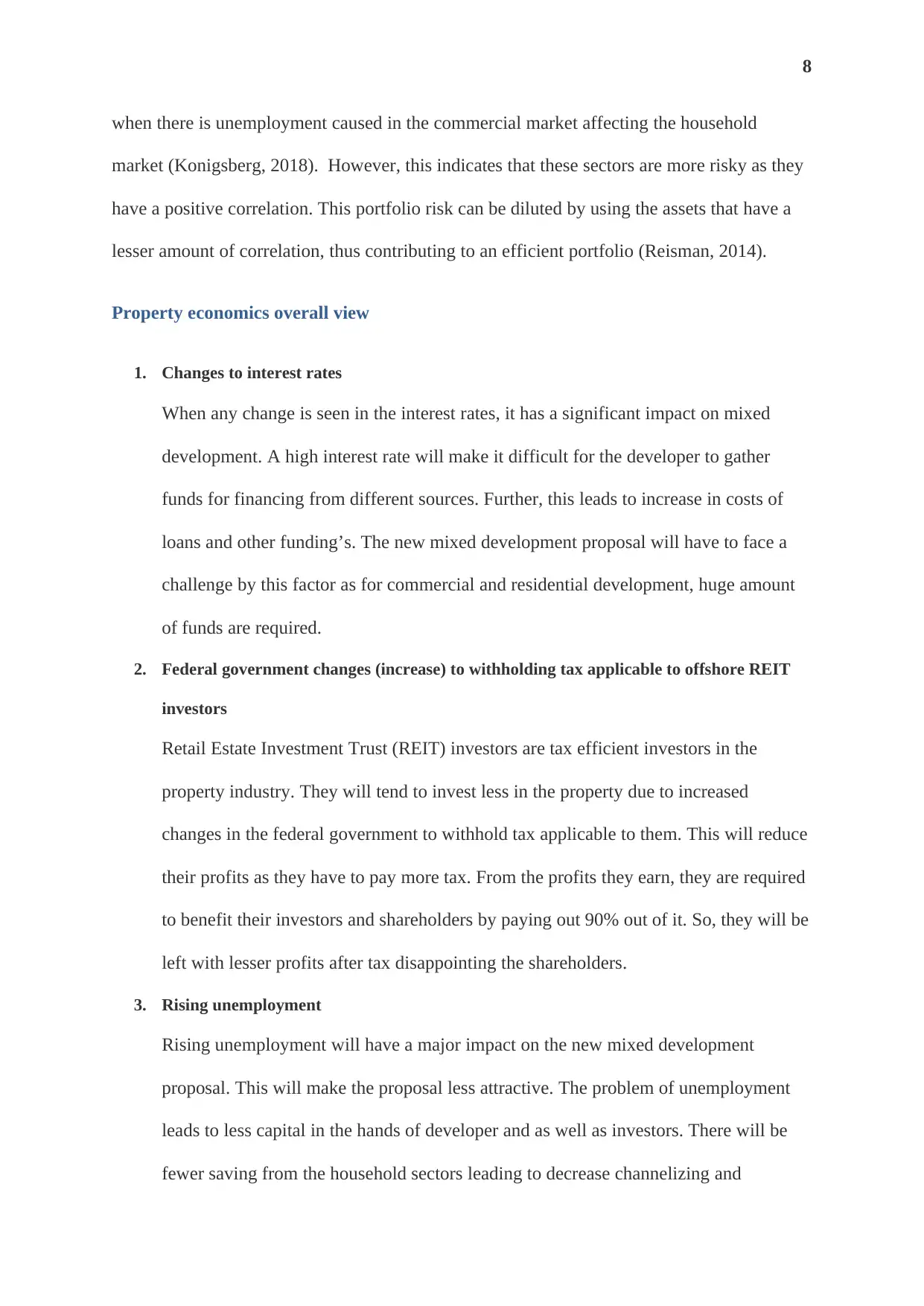
8
when there is unemployment caused in the commercial market affecting the household
market (Konigsberg, 2018). However, this indicates that these sectors are more risky as they
have a positive correlation. This portfolio risk can be diluted by using the assets that have a
lesser amount of correlation, thus contributing to an efficient portfolio (Reisman, 2014).
Property economics overall view
1. Changes to interest rates
When any change is seen in the interest rates, it has a significant impact on mixed
development. A high interest rate will make it difficult for the developer to gather
funds for financing from different sources. Further, this leads to increase in costs of
loans and other funding’s. The new mixed development proposal will have to face a
challenge by this factor as for commercial and residential development, huge amount
of funds are required.
2. Federal government changes (increase) to withholding tax applicable to offshore REIT
investors
Retail Estate Investment Trust (REIT) investors are tax efficient investors in the
property industry. They will tend to invest less in the property due to increased
changes in the federal government to withhold tax applicable to them. This will reduce
their profits as they have to pay more tax. From the profits they earn, they are required
to benefit their investors and shareholders by paying out 90% out of it. So, they will be
left with lesser profits after tax disappointing the shareholders.
3. Rising unemployment
Rising unemployment will have a major impact on the new mixed development
proposal. This will make the proposal less attractive. The problem of unemployment
leads to less capital in the hands of developer and as well as investors. There will be
fewer saving from the household sectors leading to decrease channelizing and
when there is unemployment caused in the commercial market affecting the household
market (Konigsberg, 2018). However, this indicates that these sectors are more risky as they
have a positive correlation. This portfolio risk can be diluted by using the assets that have a
lesser amount of correlation, thus contributing to an efficient portfolio (Reisman, 2014).
Property economics overall view
1. Changes to interest rates
When any change is seen in the interest rates, it has a significant impact on mixed
development. A high interest rate will make it difficult for the developer to gather
funds for financing from different sources. Further, this leads to increase in costs of
loans and other funding’s. The new mixed development proposal will have to face a
challenge by this factor as for commercial and residential development, huge amount
of funds are required.
2. Federal government changes (increase) to withholding tax applicable to offshore REIT
investors
Retail Estate Investment Trust (REIT) investors are tax efficient investors in the
property industry. They will tend to invest less in the property due to increased
changes in the federal government to withhold tax applicable to them. This will reduce
their profits as they have to pay more tax. From the profits they earn, they are required
to benefit their investors and shareholders by paying out 90% out of it. So, they will be
left with lesser profits after tax disappointing the shareholders.
3. Rising unemployment
Rising unemployment will have a major impact on the new mixed development
proposal. This will make the proposal less attractive. The problem of unemployment
leads to less capital in the hands of developer and as well as investors. There will be
fewer saving from the household sectors leading to decrease channelizing and
⊘ This is a preview!⊘
Do you want full access?
Subscribe today to unlock all pages.

Trusted by 1+ million students worldwide
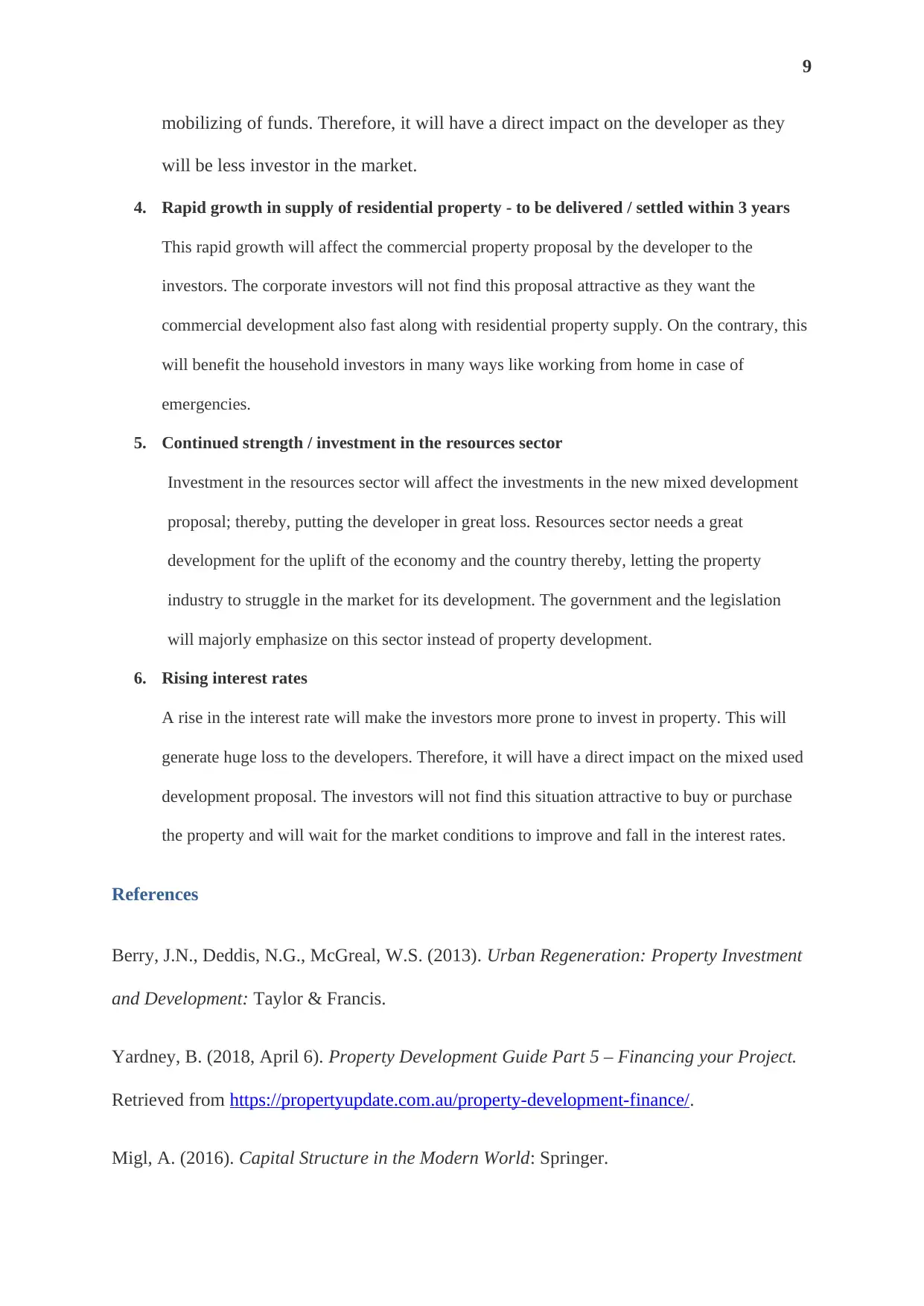
9
mobilizing of funds. Therefore, it will have a direct impact on the developer as they
will be less investor in the market.
4. Rapid growth in supply of residential property - to be delivered / settled within 3 years
This rapid growth will affect the commercial property proposal by the developer to the
investors. The corporate investors will not find this proposal attractive as they want the
commercial development also fast along with residential property supply. On the contrary, this
will benefit the household investors in many ways like working from home in case of
emergencies.
5. Continued strength / investment in the resources sector
Investment in the resources sector will affect the investments in the new mixed development
proposal; thereby, putting the developer in great loss. Resources sector needs a great
development for the uplift of the economy and the country thereby, letting the property
industry to struggle in the market for its development. The government and the legislation
will majorly emphasize on this sector instead of property development.
6. Rising interest rates
A rise in the interest rate will make the investors more prone to invest in property. This will
generate huge loss to the developers. Therefore, it will have a direct impact on the mixed used
development proposal. The investors will not find this situation attractive to buy or purchase
the property and will wait for the market conditions to improve and fall in the interest rates.
References
Berry, J.N., Deddis, N.G., McGreal, W.S. (2013). Urban Regeneration: Property Investment
and Development: Taylor & Francis.
Yardney, B. (2018, April 6). Property Development Guide Part 5 – Financing your Project.
Retrieved from https://propertyupdate.com.au/property-development-finance/.
Migl, A. (2016). Capital Structure in the Modern World: Springer.
mobilizing of funds. Therefore, it will have a direct impact on the developer as they
will be less investor in the market.
4. Rapid growth in supply of residential property - to be delivered / settled within 3 years
This rapid growth will affect the commercial property proposal by the developer to the
investors. The corporate investors will not find this proposal attractive as they want the
commercial development also fast along with residential property supply. On the contrary, this
will benefit the household investors in many ways like working from home in case of
emergencies.
5. Continued strength / investment in the resources sector
Investment in the resources sector will affect the investments in the new mixed development
proposal; thereby, putting the developer in great loss. Resources sector needs a great
development for the uplift of the economy and the country thereby, letting the property
industry to struggle in the market for its development. The government and the legislation
will majorly emphasize on this sector instead of property development.
6. Rising interest rates
A rise in the interest rate will make the investors more prone to invest in property. This will
generate huge loss to the developers. Therefore, it will have a direct impact on the mixed used
development proposal. The investors will not find this situation attractive to buy or purchase
the property and will wait for the market conditions to improve and fall in the interest rates.
References
Berry, J.N., Deddis, N.G., McGreal, W.S. (2013). Urban Regeneration: Property Investment
and Development: Taylor & Francis.
Yardney, B. (2018, April 6). Property Development Guide Part 5 – Financing your Project.
Retrieved from https://propertyupdate.com.au/property-development-finance/.
Migl, A. (2016). Capital Structure in the Modern World: Springer.
Paraphrase This Document
Need a fresh take? Get an instant paraphrase of this document with our AI Paraphraser
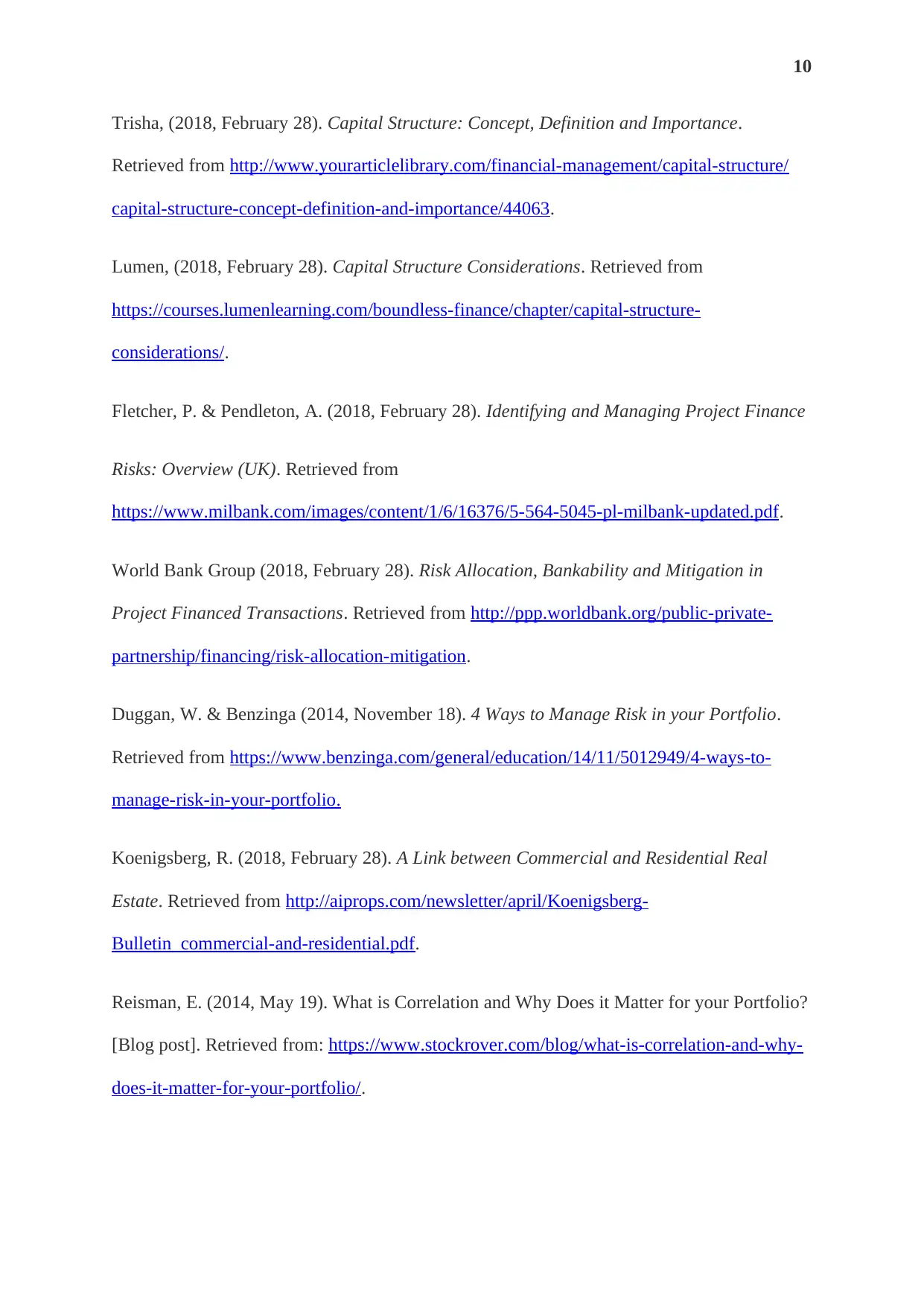
10
Trisha, (2018, February 28). Capital Structure: Concept, Definition and Importance.
Retrieved from http://www.yourarticlelibrary.com/financial-management/capital-structure/
capital-structure-concept-definition-and-importance/44063.
Lumen, (2018, February 28). Capital Structure Considerations. Retrieved from
https://courses.lumenlearning.com/boundless-finance/chapter/capital-structure-
considerations/.
Fletcher, P. & Pendleton, A. (2018, February 28). Identifying and Managing Project Finance
Risks: Overview (UK). Retrieved from
https://www.milbank.com/images/content/1/6/16376/5-564-5045-pl-milbank-updated.pdf.
World Bank Group (2018, February 28). Risk Allocation, Bankability and Mitigation in
Project Financed Transactions. Retrieved from http://ppp.worldbank.org/public-private-
partnership/financing/risk-allocation-mitigation.
Duggan, W. & Benzinga (2014, November 18). 4 Ways to Manage Risk in your Portfolio.
Retrieved from https://www.benzinga.com/general/education/14/11/5012949/4-ways-to-
manage-risk-in-your-portfolio.
Koenigsberg, R. (2018, February 28). A Link between Commercial and Residential Real
Estate. Retrieved from http://aiprops.com/newsletter/april/Koenigsberg-
Bulletin_commercial-and-residential.pdf.
Reisman, E. (2014, May 19). What is Correlation and Why Does it Matter for your Portfolio?
[Blog post]. Retrieved from: https://www.stockrover.com/blog/what-is-correlation-and-why-
does-it-matter-for-your-portfolio/.
Trisha, (2018, February 28). Capital Structure: Concept, Definition and Importance.
Retrieved from http://www.yourarticlelibrary.com/financial-management/capital-structure/
capital-structure-concept-definition-and-importance/44063.
Lumen, (2018, February 28). Capital Structure Considerations. Retrieved from
https://courses.lumenlearning.com/boundless-finance/chapter/capital-structure-
considerations/.
Fletcher, P. & Pendleton, A. (2018, February 28). Identifying and Managing Project Finance
Risks: Overview (UK). Retrieved from
https://www.milbank.com/images/content/1/6/16376/5-564-5045-pl-milbank-updated.pdf.
World Bank Group (2018, February 28). Risk Allocation, Bankability and Mitigation in
Project Financed Transactions. Retrieved from http://ppp.worldbank.org/public-private-
partnership/financing/risk-allocation-mitigation.
Duggan, W. & Benzinga (2014, November 18). 4 Ways to Manage Risk in your Portfolio.
Retrieved from https://www.benzinga.com/general/education/14/11/5012949/4-ways-to-
manage-risk-in-your-portfolio.
Koenigsberg, R. (2018, February 28). A Link between Commercial and Residential Real
Estate. Retrieved from http://aiprops.com/newsletter/april/Koenigsberg-
Bulletin_commercial-and-residential.pdf.
Reisman, E. (2014, May 19). What is Correlation and Why Does it Matter for your Portfolio?
[Blog post]. Retrieved from: https://www.stockrover.com/blog/what-is-correlation-and-why-
does-it-matter-for-your-portfolio/.

11
Kobzeff, J. (2016, July 19). Capitalization Rate: How to Compute and Use. Retrieved from:
http://www.proapod.com/Articles/capitalization_rate.htm.
Kobzeff, J. (2016, July 19). Capitalization Rate: How to Compute and Use. Retrieved from:
http://www.proapod.com/Articles/capitalization_rate.htm.
⊘ This is a preview!⊘
Do you want full access?
Subscribe today to unlock all pages.

Trusted by 1+ million students worldwide
1 out of 12
Related Documents
Your All-in-One AI-Powered Toolkit for Academic Success.
+13062052269
info@desklib.com
Available 24*7 on WhatsApp / Email
![[object Object]](/_next/static/media/star-bottom.7253800d.svg)
Unlock your academic potential
Copyright © 2020–2025 A2Z Services. All Rights Reserved. Developed and managed by ZUCOL.





